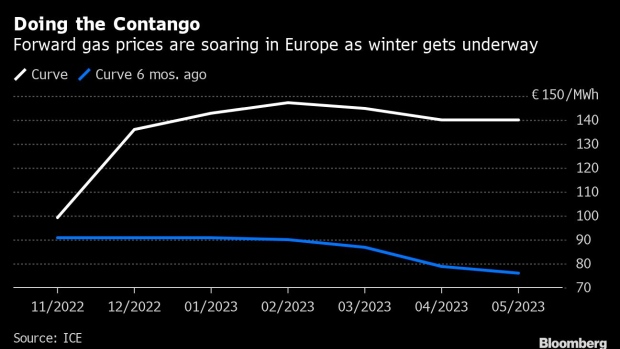Oct 25, 2022
Too Much Gas. Europe’s Energy Crisis Has Surprise Turn
, Bloomberg News

(Bloomberg) -- Europe suddenly has more gas than it can use.
Starved of the Russian imports on which its long relied, Europe has rushed to import liquefied natural gas from around the world to fill up storage. Now, a combination of unusually warm weather and successful bidding for cargoes means facilities are almost full before Europeans have even turned the thermostats up. Gas prices have also fallen back sharply, and are less than a third of their summer peak.
Risks still lie ahead: much depends on the weather, and a cold snap would quickly see Europe dipping into its stockpiles. Governments are also on edge about the threat of more sabotage on energy assets that could upend the market. But at the end of October, the continent is in better shape than policy makers dared hope.
Gas supplies from Russia have been shrinking since last year. Flows on the key Nord Stream pipeline were halted this summer before several blasts damaged the link last month. Mild weather is helping limit demand for now but European policymakers are worried that lower gas prices -- relative to the summer spike -- will spur higher consumption when temperatures drop.
“The European gas glut is expected to last until at least December,” said Giacomo Masato, lead analyst and senior meteorologist at the Italian energy company Illumia. “It is unlikely Europe will see a prolonged cold spell in November.”
Gas is near the lowest since June, though the dangers are still in the market pricing. February futures are trading at a 44% premium to November, and costs for next winter are also higher, showing that supply issues are expected to persist.
All that means that reducing usage, despite the lure of lower prices, remains essential. According to Timera Energy, gas demand reduction across 2022 is estimated at about 7-9%, “mostly driven by shut in of large industrial consumers”. “However this is short of the EU’s 15% target.
“Europe’s ability to navigate a parallel power and gas crisis across the next two years depends strongly on its ability to reduce demand,” analysts at Timera said in a blog. “We think the crisis is far from over.”
Europe’s efforts to build up stockpiles means European storage is 93.6% full and Germany is at 97.5%, according to Gas Infrastructure Europe. While that’s providing some comfort to the market, in Germany it’s only enough to meet demand for two months of colder weather so Europe will need to keep attracting cargoes of LNG.
But the weather looks set to stay milder-than-usual well into November, according to Bloomberg’s weather model.
For now, ships keep arriving. Northwest Europe is on track to receive 82 tankers of LNG this month, 19% more than in September. More vessels are staying longer in so-called floating storage in anticipation of higher prices and amid limited capacity to receive the fuel, according to shipbrokers Fearnleys A/S. This situation that may last until mid-January, according to Oystein Kalleklev, chief executive of LNG shipowner Flex LNG Ltd. in Oslo.
Bloomberg’s index for loaded tankers on the water for 20 days or more has risen to the highest since at least 2017. Last week, Spain’s Enagas SA warned it may need to limit numbers as it has little room to absorb excess imports.
While prices are falling now, demand from Asia could pick up and Russia could still end flows of gas that transit Ukraine, either purposefully or through infrastructure damage as fighting continues. Both would add upward pressure on prices, and also make filling storage more difficult next year.
Meanwhile, European energy ministers are also discussing a temporary cap on benchmark gas prices. One of the main arguments against the measure is that it may make it more difficult for Europe to keep on attracting the LNG it needs this winter.
“As temperatures start to drop and storages get emptied, the market reality of supply-demand mismatch will mean higher prices, translating into further inflationary pressures,” said Katja Yafimava, senior research fellow at the Oxford Institute for Energy Studies. “This problem is likely to become more acute during the next winter.”
--With assistance from Elena Mazneva and Andrew Reierson.
(Updates with industrial demand reduction. An earlier version of this story corrected the spelling of Giacomo Masato)
©2022 Bloomberg L.P.





